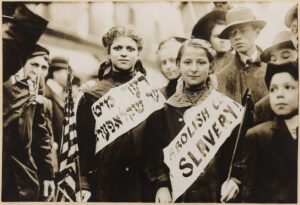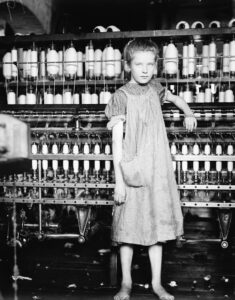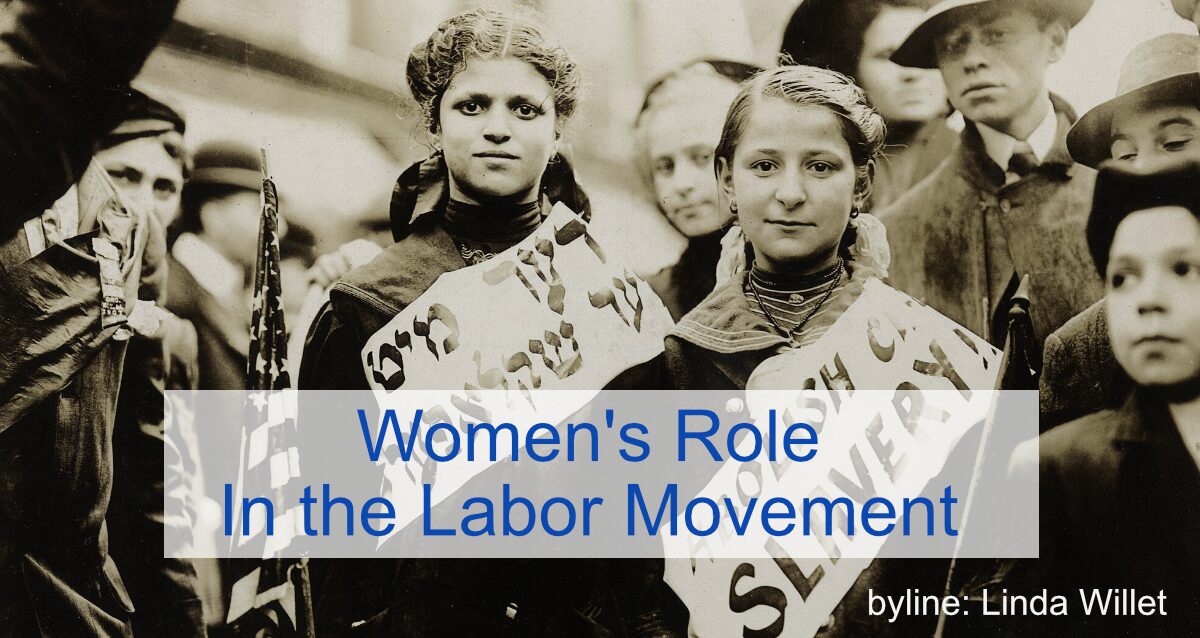America had a bustling factory textile industry beginning in the early 1800s. Cotton from Southern plantations was shipped to the east. Many young women and girls from rural communities found work in the textile mills. The Lowell Textile Mills in Lowell, Massachusetts were among the most famous mills and regarded as modern and advanced. However, the young girls who worked there told a different story about working conditions. The girls worked an average of 13 hours a day and were controlled every moment since they lived in corporation-owned housing. A 12-year-old girl named Lucy Larcome said that she “hated the confinement, noise, and lint-filled air, and regretted the time lost to education.” Another girl named Amelia described her circumstances as worse than “the poor peasant of Ireland.”

The young girls in the mills were courageous. In 1834 and 1836, the girls went on strike (“turned out”) because of pay cuts and convinced workers at other mills to join them. However, the managers had more power, and within a week, the strike ended. From this effort, the girls learned how to organize, and they had a champion named Sarah Bagley who had worked in several mills and edited a labor newspaper, The Voice of Industry. In 1840, they formed the Lowell Female Labor Reform Association and campaigned to reduce working hours to 10 hours a day. The campaigners got thousands of signatures on petitions, published tracts, set up chapters in other towns, and testified before the state legislature. They convinced Lowell to accept a 11-hour workday for the Lowell Mills, but it was years before a 10-hour workday, which was unenforceable, was passed. However, many women admired the efforts of the mill girls and used the same strategies in the antislavery movement.
Following the Civil War, textile mills also sprang up in the agricultural south. Many southern farmers were in economic distress in the 1880s and 1890s and thought that mill villages that employed the whole family would keep the family together. The millowners built mill houses, company stores, schools, and churches, so that workers never left the mill village. Parents and children worked 10- to 12-hour days. Pay was low, and families were sometimes paid with coupons that could be spent at the company store. Families made just enough to survive and were in perpetual debt to the millowners.
On March 12, 1929, 500 female workers from Glanzstoff Mill walked out after a supervisor named Margaret Bowen was denied pay increases for her department and ridiculed for asking. Within a few days, all female and male employees from Glanzstoff and also Bemberg walked out in sympathy with the 500 workers. The strikers obtained a charter from the United Textile Workers and set up a picket line. The businessmen in town were outraged that women started this walkout and convinced the governor to send armed troops with machine guns and guardsmen to guard the roads. Violence ensued, and water lines and some properties were destroyed.

Some young women in the South were not forced to work in the factories but chose to leave the family farm, believing that working in a mill would give them their own money and be more interesting than daily farm chores. Two German rayon companies Bemberg and Glanzstoff Mills moved into the Appalachians (Elizabethtown, Carter County, Tennessee), thinking that they could take advantage of young women with little education. However, the factory owners were not aware of the fierce independence of mountain people. The women in these factories were ordered to work long days with exposure to the dangerous chemicals used to make rayon with half the pay of male workers. Women were also treated differently than men. Unlike male workers, they were constantly monitored and watched. Sometimes they were not allowed to take bathroom breaks.
The young girls would not back down. They continued to protest and blocked roads so strikebreakers could not get in. The strikers marched through town draped in flags, forcing the military guards to present arms each time they walked by. The teenagers put their resources together and helped fellow workers who no longer had an income. Three months later, in May 1929, the governor withdrew the troops. Mediators worked out a deal where the companies agreed to hire back all striking employees, listen to employee grievances, and not discriminate against union members. However, because of lack of resources, the UTW contract did not address working conditions, treatment of women, long hours, or equal wages. The women were disappointed when it became evident that conditions at the two companies were not changing, and many of the strikers were still blacklisted. Most of the young women returned to the family farm or found domestic work. Some decided to be labor organizers.
Was it all for nothing? No. These young girls inspired other movements. And they learned to speak up for themselves and fight for fairness and equity. Following this strike, a wave of strikes occurred in North and South Carolina. And the action of these girls was repeated by women in the suffrage movement. The mill girls inspired a song written by the Lee Brothers in 1930, “Cotton Mill Girls.” A version of this song was recorded by Hedy West and used in the 1960s labor movement protests.
Author’s Footnote: It is hard to believe, but a version of these mill towns still existed in my childhood days in the 1950s and 1960s, and my family was part of the mill story. During the Depression, my father quit school and worked first at a movie theater and then in a mill to bring money home to the family. One day, he showed me a mill that he had worked in at age 15, He said that he hated mill work, but it was one of the few jobs you could get before World War II. After serving in the war, he became a supervisor in the Whitnel Cotton Mill, near Lenoir, N.C. During my preschool years, we lived in a large house near the mountains, which was a mill-owned house. As a supervisor, my dad was paid well, but he told us that mill conditions were unhealthy because you inhaled a lot of cotton lint and the loud machines damaged your hearing. And he felt that the workers were not treated fairly by management. He found a different job within a few years, and he emphasized that we needed a college education to avoid the kind of working conditions that he endured as a child and young man.
Tedesco, Marie. “Elizabethan Rayon Plant Strikes, 1929,” Tennessee Historical Society, March 1, 2018. https://tennesseeencyclopedia.net/entries/elizabethton-rayon-plants-strikes-1929/
Griffin, Stephen. “Cotton Mills Girls’ Folk Song”
https://www.stephengriffin.com/folksongindex/cotton-mill-girls/
Shirley, Neal and Saralee Stafford. “Wild Hearts in the Southern Mills: Women in the Strikes Against the Textile Industry. 1929-1930” in Dixie Be Damned: 300 Years of Insurrection in the American South. 147-157. Oakland: AK Press, 2015.
https://nps.gov/…/learn/history/culture/the-mill-girls-of-lowell
Search for the following articles by author name: Anderson, Delonda. “Unwomanly Actions in Appalachia’s Labor Movement,” March 16, 2021.
Dowd Hall, Jacquelyn. “Disorderly Women: Gender and Labor Militancy in the Appalachian South.

